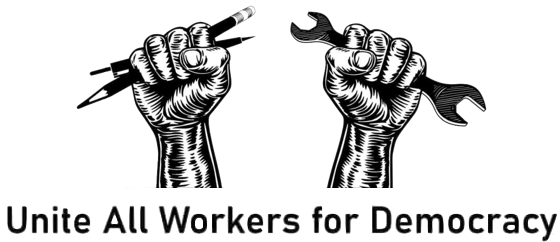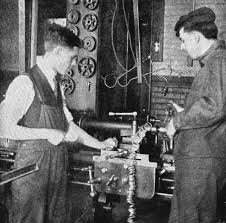Follow Erik Loomis on Twitter
Read Erik Loomis’ work at Lawyers, Guns, & Money
Historian Erik Loomis on This Day in Labor History: August 11, 1911. Workers at the Watertown Arsenal in Watertown, Massachusetts walked off the job as the scientific management ideas of Frederick Winslow Taylor began to be applied to their work. Let’s talk about workers resisting bosses timing them!
I guess the way to start this today is to get everyone to think about what we’ve lost in our work cultures over the years. The strikes of the past were often fighting for things that we can’t even imagine today. That’s because we’ve been so beaten down by employer control.
Here’s an example: During arguments around the Flint sit-down strike in 1937, UAW lawyers made the case that workers had a property right to their jobs. Of course companies and courts rejected this. But it was a real legal argument many believed in. This would be unthinkable now.
And in the 19th and early 20th centuries, as the great labor historian David Montgomery so skillfully explored, the top issue for workers wasn’t wages or revolution or whatever. It was controlling their work cultures from employer domination. They struck again and again over this.
Today, we have no control over our work cultures. We are under total control from management. Really, I — as a professor — am in almost the only job where this isn’t true, which is a major reason why universities are undermining tenure and hiring contingent laborers.
Now, onto the specifics of today’s thread, a key moment in that lost struggle.
Frederick Winslow Taylor was an aristocratic Philadelphian who after a few years working as a manual laborer, chose to dedicate his life to making industrial labor more efficient and streamlined.
He began managing some Maine paper mills before starting his own efficiency practice in Philadelphia in 1893. His first big job was with Bethlehem Steel between 1898 and 1901, when he was forced out for clashing with other managers, a frequent problem for the bullheaded Taylor.
Taylor believed that workers were nothing more than inefficient machines, and like real machines, could be time and trained to do more work at a greater speed for less money per unit, thus increasing both productivity and profit.
Taylor himself publicized his work in his famous book, The Principles of Scientific Management, published in 1911. Interestingly. Taylor didn’t come up with the term “scientific management.”
Rather, he borrowed it from Louis Brandeis, who coined it the year before in arguing a case about railroads before the Interstate Commerce Commission, borrowing from Taylor’s ideas to argue that railroads could raise wages without raising freight rates.
Taylor fundamentally thought working people were stupid, a not uncommon belief for the Gilded Age. He once said: ” labor should include rest breaks so that the worker has time to recover from fatigue. Now, one of the very first requirements for a man who is fit to handle pig iron as a regular occupation is that he shall be so stupid and so phlegmatic that he more nearly resembles in his mental make-up the ox than any other type. The man who is mentally alert and intelligent is for this very reason entirely unsuited to what would, for him, be the grinding monotony of work of this character. Therefore the workman who is best suited to handling pig iron is unable to understand the real science of doing this class of work.”
Taylor’s ideas, and those of other pioneers of scientific management, became popular among the nation’s industrialists by the 1900s.
As increasingly huge corporations sought to maximize profit, controlling the lives of workers on the shop floor became more appealing. While the industrial system had long exploited workers, in many ways, workers still ran the shop floors with a significant degree of autonomy.
The long cherished freedom of individual labor had long disappeared by the early 20th century, but the masculine idea of a man having some control over his labor remained strong.
In 1909, General William Crozier — head of the Army Ordnance Department — visited Taylor about his methods. This military facility was one of the nation’s largest arsenals, established in 1816 but turned into a site of gun carriage manufacturing only in 1892.
Taylor and his acolytes, particularly Carl Barth, began implementing Taylorist ideas of reorganization. This immediately got the attention of workers — not only in Watertown but around the country.
The International Association of Machinists urged members to complain to their congressmen. But when Taylor sent Dwight Merrick to Watertown in May 1911 with a stopwatch to time workers, the workers erupted in fury.
Taylor warned the officers to not completely implement a time study plan without prior preparation of the workers, but seeking quick results they did anyway. The workers then walked off the job after one worker refused to allow Merrick to time him and was fired for subordination.
The Watertown molders wrote to Lieutenant Colonel C.B. Wheeler, commanding officer of the arsenal: “Dear Sir: The very unsatisfactory conditions which have prevailed in the foundry among the molders for the past week or more reached an acute stage this afternoon when a man was seen to use a stopwatch on one of the molders. This we believe to be the limit of our endurance. It is humiliating to us, who have always tried to give to the Government the best that was in us. This method is un-American in principle, and we most respectfully request that you have it discontinued at once. We feel justified in making this request, on the ground that some two years ago you told a committee of the molders that you were well satisfied with the output of that department. Also, Gen. Crozier gave his word to a committee that waited upon him in Washington that he would not install any part of the Taylor system that might be objectionable to the men; and we assure that this part of the system will not be tolerated by the molders.”
I love this letter because you can really feel the outrage. These men are insulted. They have pride in their work and they work hard. And then some college boy with a stopwatch comes around and tells them they aren’t working hard enough!
That new technology must be used to speed up their work! No way!
Moreover, they show how often early Taylorism was a total failure because rather than increase efficiency, they caused strikes. Taylor’s hard-headed ways of running these experiments routinely led to these problems, and thus, most of his personal work was a failure.
The strike itself was short, lasting only until August 18, when the fired worker was reinstated and the Ordinance Department promised an investigation of the new management techniques.
Taylor was furious that the officers had not followed his plans to the tee, and thus, precipitated the strike and the bad publicity that went along with it. The strike led to hearings in the House Labor Committee over Taylorism.
They were testy, in no small part, because Taylor was not good at hiding his contempt for workers and their dignity.
When asked by Rep. William Wilson, a former official of the United Mine Workers and future Secretary of Labor under Woodrow Wilson, about his method, Taylor said “the ordinary pig-iron man is not suited for shoveling coal because he is too stupid. But a first-class man who could lift a shovel weighing twenty one and a half pounds could move a pile of coal lickety-split.”
Wilson responded, “but what about the effects on a man who wasn’t first-class?
Taylor dismissed the concern: “Scientific management has no place for a bird that can sing and won’t sing.” Wilson was furious: “We are not dealing with horses nor singing birds, but we are dealing with men who are part of society and for whose benefit society is organized”
Oh, how antiquated, thinking workers were humans.
Congress did act on the workers’ anger, first taking apart Taylor’s system at Watertown and later banning the use of stopwatches to time workers in factories.
Taylor personally suffered a major setback here, but his ideas of scientific management and efficiency based upon making workers’ lives worse continued to advance.
No one did more on this front than Henry Ford, whose vaunted $5 a day wage has given him an unjustified reputation as a humane boss.
But the reality was that Ford extracted his pound of flesh for that $5, working laborers so hard and with such speed and efficiency that many simply could not handle the work there and had to quit.
Treating workers like machines became central to American labor management practices, with the eventual hope to just replace them with machines.
That’s a project that would prove quite successful beginning in the second half of the twentieth century and contributing significantly to the decline of working-class power and economic stability by the latter part of the century.
What’s interesting about all this is that as labor realized that the old 19th century control over work wasn’t coming back, the AFL began to work with some of Taylor’s more progressive acolytes on big planning projects that would create efficiency that would also help workers.
And those projects were instrumental in laying the early groundwork of the New Deal, where workers absolutely had no control over their work, but where they also got paid for that and the right for unions.
The site of the Watertown Arsenal is today a mall outside Boston. So if you go there and see some worker miserable in some store, who has zero control over their work culture today and making a crap wage, think about the history of worker control on that very spot.
For further reading on these issues, see Sanford Jacoby’s Employing Bureaucracy.

